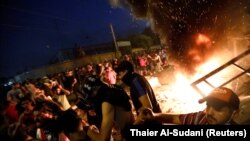The Islamic Republic of Iran is officially adopting the conspiracy theory that protests in Iraq have been organized by the United States and its regional allies to change or weaken the Iraqi government in order to establish their control over the country, to the detriment of Iran’s interests.
In its Saturday, October 5 issue, the official IRNA, controlled by President Hassan Rouhani’s administration, in a long lead-article sounded the alarm that “planners” of protests in Iraq aim at hitting multiple birds with one stone.
The targets of the plotters IRNA says, is “toppling, weakening or pressuring Iraq’s leaders to make them surrender” to their interests. In addition, the plotters want to weaken Iraq’s relations with Iran, including ties among Shiites, who constitute the majority in both countries.
During a tumultuous week of unrest in Iraq, IRNA is the only large news outlet in the world that blames the unrest on machinations of foreign governments rather than the frustration of ordinary Iraqis who are disillusioned with corruption and mismanagement in their government. IRNA’s words in this case simply reflect the ideas of Iran’s leaders.
In fact, anger at corruption and a serious deterioration in living standards goes far beyond Iraq’s borders in the region. Rare protests in Egypt calling for the ouster of military strongman turned president, Abdul Fattah al-Sisi can hardly be ascribed to plots by the U.S. and Saudi Arabia.
Similarly, grassroots protests in Lebanon against corruption and a paralyzed government are not much different from what is happening in Iraq.
Beneath the frustration of many Iraqis is a sectarian political elite, composed of major Shiite groups which are often influenced by Iran to various degrees. Since the U.S. invasion in 2003 and the formation of a fragile and imperfect democratic system in Iraq, Tehran has tirelessly worked to spread its influence among Iraqis, especially the Shiite community. It is no secret that before and after each election, Iranian officials and even its military leaders, such as Qods force commander Qassem Soleimani shuttle back and forth trying to forge alliances and voting blocks.
In fact, in September 2018, pro-Iranian politicians were elected to the leadership posts of Iraq’s parliament.
Therefore, one can hardly be surprised if disgruntled Iraqis, who want to have relative social and economic security given the country’s vast oil wealth, to partly blame Iran for their inadequate living standards.
IRNA in its lead article after blaming the protests on conspirators, goes on to divide the Iraqi protesters into two groups; the peaceful ordinary citizens with legitimate grievances and a smaller sinister group organized by foreigners, which is after destruction of the ruling system and Shiite sanctities.
But news reports from diverse sources have not mentioned any such groups or divisions among protesters, which at least in Baghdad were not armed and simply came out to vent their anger.
Nevertheless, the Iraqi government decided to show force and opened fire on protesters. Reuters reported on October 4 that its correspondents saw snipers on rooftops targeting individual protesters. This is eerily similar to what was reported in 2009 in Iran during mass protests.
By claiming that among protesters there are organized groups with sinister aims seems to be an attempt to justify the use of military force against unarmed civilians.
There are media reports and social media postings showing protesters angry at the alleged role of Iran and Iranian forces even in the suppression of protests. In one video a protester says he has taken a vest from an Iranian who was part of the force confronting the Iraqis. Clearly, some protesters believe Iranians are firing at them, not the Iraqi security forces.
Iran’s leadership might also be concerned about the danger of spillover. Economic conditions in Iran are not much better, or even worse than in Iraq in some instances. Less than two years ago there was similar mass unrest in Iran, which shook the ruling establishment.
The current unrest in Arab countries, especially in neighboring Iraq can trigger similar protests in Iran.
The protests in Egypt, Lebanon and Iraq are generally seen to be about people losing hope of having a relatively normal existence if not progress. Interestingly, the protests do not seem to be related to dictatorial or democratic forms of government. Egypt is clearly ruled by an autocrat, while in Lebanon there is freedom of speech, elections, factions and typical horse-trading among politicians. Iraq also has at least the outlines of an emerging democracy, with regular elections and open election campaigns.
But corruption and inefficiency by organized political parties and career politicians who are best positioned to campaign and win elections, have made them immune from accountability. In both Iraq and Lebanon factionalism and a weak legal system make their democracies vulnerable to the tendency of bubbling political fiefdoms within the system and many citizens know it.







